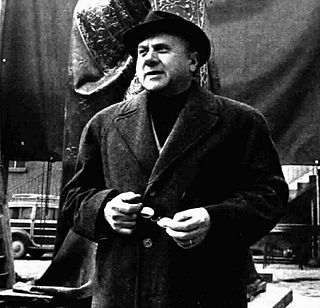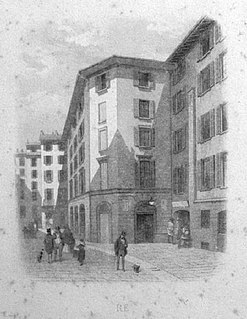
Amilcare Ponchielli was an Italian opera composer, best known for his opera La Gioconda. He was married to the soprano Teresina Brambilla.

RAI – Radiotelevisione italiana is the national public broadcasting company of Italy, owned by the Ministry of Economy and Finance.

Bruno Maderna was an Italian conductor and composer.

The Milan Conservatory is a college of music in Milan, Italy.
Différences is a composition by the Italian composer Luciano Berio for flute, clarinet, viola, cello, harp and magnetic tape, dating 1958–59. It was written for the Domaine musical concerts in Paris and first performed in March 1959, conducted by Pierre Boulez.
The music of Milan has ancient roots. The Ambrosian chants are among the first codified music in Western culture, which fact led to the later development of its concept of scales, for example. In more recent history, the city of Milan has been an important social, cultural, political and commercial center not just in Italy, but in all of Europe.

Lorenzo Ferrero is an Italian composer, librettist, author, and book editor. He started composing at an early age and has written over a hundred compositions thus far, including twelve operas, three ballets, and numerous orchestral, chamber music, solo instrumental, and vocal works. His musical idiom is characterized by eclecticism, stylistic versatility, and a neo-tonal language.

Cesare Valletti was an Italian operatic tenor, one of the leading tenore di grazia of the postwar era. He was much admired for his polished vocal technique, his musical refinement and elegance, and beauty of tone.

Roberto Musci is an Italian music composer, saxophonist, guitarist, and video producer. From 1974 to 1985 he studied African, Indian, and Near & Far Eastern music. During this time, he recorded field recordings and collected musical instruments. His music combines non-European and contemporary music that includes techniques derived from plunderphonics and musique concrète to create a personal musical language with which he tells stories inspired by his travels.
Alberto Mantelli was an Italian musicologist and music critic.

Francesco Messina was an Italian sculptor of the 20th century.
Thema is an electroacoustic composition by Luciano Berio, for voice and tape. Composed between 1958 and 1959, it is based on the interpretative reading of the poem "Sirens" from chapter 11 of the novel Ulysses by James Joyce by Cathy Berberian and on the elaboration of her recorded voice by technological means.

The Museum of Musical Instruments of Milan exhibits over 700 musical instruments from the fifteenth to twentieth centuries with particular attention to Lombard instruments. The collection contains plucked instruments, Lombard and Cremonese violins, hunting horns, numerous wood instruments, bassoons, pianos and some ancient organs. In particular the Cremonese lutherie is appreciated all over the world for the high quality of its musical instruments. The museum also displays the equipment of the former Studio di fonologia musicale di Radio Milano.

Luca Francesconi is an Italian composer. He studied at the Milan Conservatory, then with Karlheinz Stockhausen and Luciano Berio.
Scambi (Exchanges) is an electronic music composition by the Belgian composer Henri Pousseur, realized in 1957 at the Studio di fonologia musicale di Radio Milano.

SIAE MICROELETTRONICA is an Italian multinational corporation and a global supplier of telecom network equipments. It provides wireless backhaul and fronthaul solutions that comprise microwave and millimeter wave radio systems, along with fiber optics transmission systems provided by its subsidiary SM Optics.

Contrappunto dialettico alla mente is a composition for two-channel magnetic tape by Italian composer Luigi Nono. It was composed in 1968.

... sofferte onde serene ..., ALN 42, is a composition for piano and tape by Italian composer Luigi Nono. The Archivio Luigi Nono uses the form ..... sofferte onde serene ..., derived from the cover of the manuscript.

Leonardo3 is an interactive museum and exhibition center at Galleria Vittorio Emanuele II, Piazza della Scala, Milano, Italy. The museum is devoted to Italy’s notable personality Leonardo da Vinci and portrays him both as an artist and inventor.

The Teatro Re was a theatre in Milan, located near the Piazza del Duomo and named for its proprietor, Carlo Re. It functioned as both a prose theatre and an opera house and saw the world premieres of numerous operas, including four by Giovanni Pacini. Designed by Luigi Canonica, the theatre was inaugurated in 1813, closed in 1872, and demolished in 1879.















